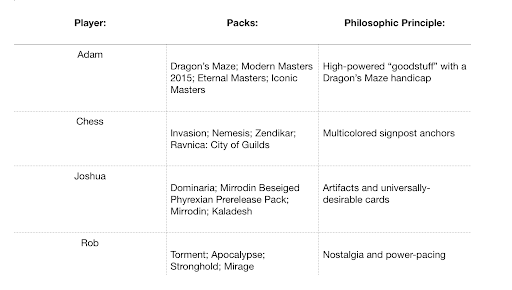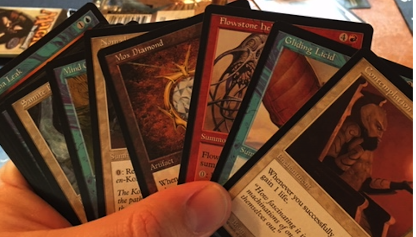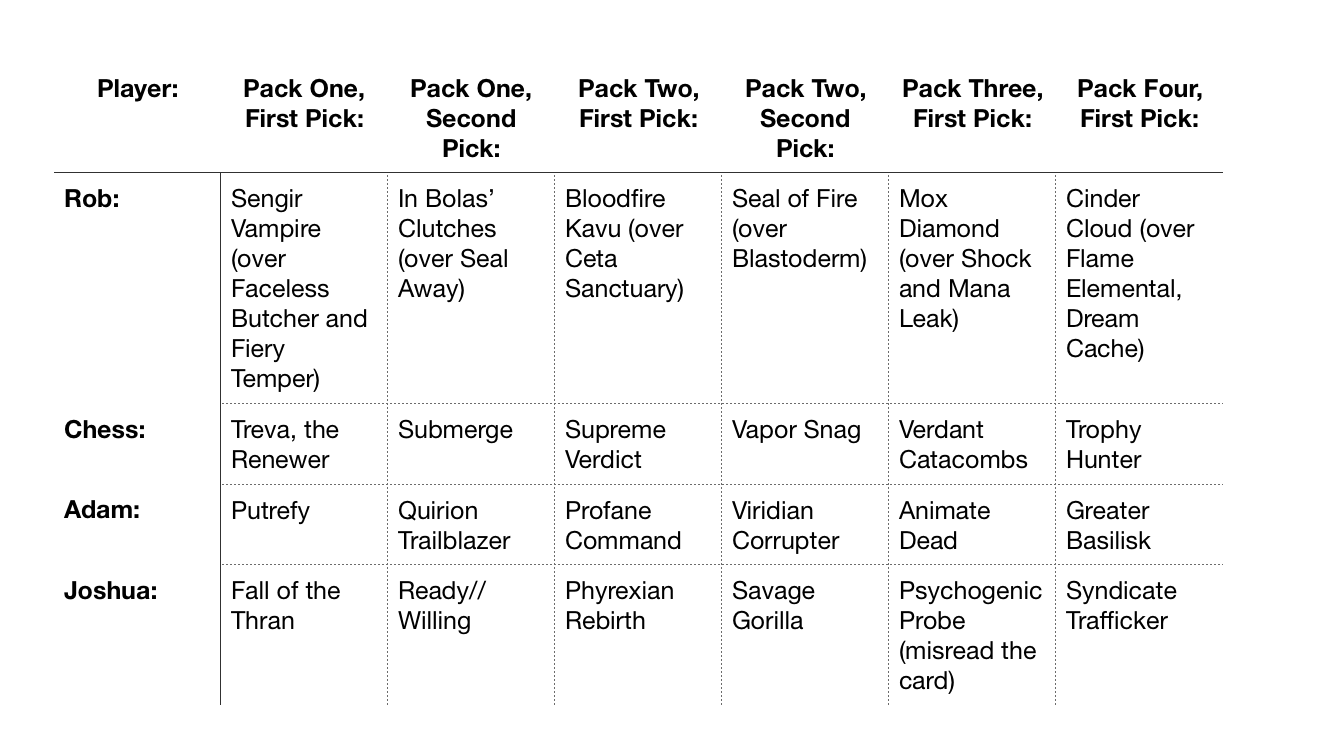Every Limited player has a favorite draft format, and one of the things they love best about those formats is telling you about it. I’ve been known to bend everyone’s ear about the time I got a fourth-pick Cursed Scroll in Tempest Remastered, or the time I went infinite with triple Time Spiral. But those draft formats, and the stories they breed, pale in comparison to one that’s unique every single time you draft. One format combines the creativity of Cube and the untrodden territory of your first draft ever: Chaos Draft.
Drafting becomes somewhat self-directed after a while. You learn what cards are the best in the format, how the archetypes interlock, how to guide your neighbors based on what’s left in the pack, etc. There’s a lot of joy in that level of mastery, but it can feel like you’re on autopilot. So what happens when you throw a curveball? What happens when every draft is a first draft, when you can’t read colors, predict upcoming removal, or even remember what every card does? That’s the beauty of Chaos Draft.
In the format, traditionally, each player brings one pack each of three different sets, the packs are shuffled or drawn randomly, raffle-style, and the draft proceeds as normal. At its best, it’s the power of Cube with the excitement of opening sealed packs. At its worst, it’s a hilarious omnishambles.
Earlier this month, we chaos drafted at my house after an absolutely brutal workweek. We decided to ramp up the silliness: instead of eight players, we condensed to four, and in lieu of three packs each, four. I chose the packs from a selection I’ve been curating since my first real job.
The packs we wound up with were:

I spent years collecting these packs and hours debated how best to group them and dole them out. With experience, I’d make some changes. First of all, the promotional Mirrodin Besieged pack was miserable—just enough Infect to be dangerous and too few ways to counteract it—and Nemesis was too parasitic and removal-free. I had forgotten about how prevalent the Rebels/Mercenaries were in the set, leaving us with several tutoring engines without targets to tutor. Likewise, I’d forgotten Blastoderm, the Green Abyss, but I support that card’s presence in every draft.
I also knew my packs would be hit-or-miss: either I’d get some real power, or I’d wind up with unplayable and verbose pre-Modern rares.
Turns out there were more hits than duds:

(Promotional consideration provide by Coca-Cola and Trader Joe’s dried dragonfruit)
But that was my third pack, and I don’t want to get ahead of myself, so let’s start with the most important part: P1P1.
Having an iota of self-awareness, I knew I’d more likely than not end up playing black, so I started with my Torment pack. I was rewarded with an extremely difficult choice: Sengir Vampire or Faceless Butcher, the quintessential Bomb vs. Removal pick. I think Butcher is generally the correct pick here, but you know I had to go with a classic. Everyone else’s picks, broken down:
 I ended up with a lovely Izzet deck splashing black for the Vampire and Gloomdrifter. (That was probably a trap—I should have bit the bullet and cut black.) Chess was running Bant Excellent Stuff with Treva, the Renewer and wheeled Armadillo Cloak. Joshua’s drafted Abzan Goodstuff with a lifegain subtheme; while Adam constructed a green/black deck that was oddly traditional for such an absurd format, with a tight curve, removal, and some tricks. Chess ended up with the Apocalypse “combo” of Unnatural Selection plus Coastal Drake—bounce any creature for the low price of 2(U) and a tap!—but cut it before we shuffled up.
I ended up with a lovely Izzet deck splashing black for the Vampire and Gloomdrifter. (That was probably a trap—I should have bit the bullet and cut black.) Chess was running Bant Excellent Stuff with Treva, the Renewer and wheeled Armadillo Cloak. Joshua’s drafted Abzan Goodstuff with a lifegain subtheme; while Adam constructed a green/black deck that was oddly traditional for such an absurd format, with a tight curve, removal, and some tricks. Chess ended up with the Apocalypse “combo” of Unnatural Selection plus Coastal Drake—bounce any creature for the low price of 2(U) and a tap!—but cut it before we shuffled up.
To fully live up to the “chaos” theme, we started with a four-player multiplayer game. That started with Adam’s aggressive curve of Simic Initiate, Flensermite, and grafting the counter onto the Infect Gremlin. That doled out two poison counters to each of us before biting the dust—along with fourteen other dudes—from a well-timed Supreme Verdict, setting Joshua up for a shockingly effective Invigorating Falls for nineteen life.
When I said this format was silly, I meant it. Consider this exchange, halfway through the game.
CHESS
(nonchalantly)
Tap three for Gliding Licid.
JOSHUA
(possibly one of the smartest people I’ve ever met, upon scanning the card)
…what…?
Luckily, the Licid didn’t last long, so we never needed to figure out precisely how it worked. Instead, we battled it out—including a barnstorming Ready // Willing from Joshua that kept him in the game—until we were all under ten life. I eventually killed Chess with Cinder Cloud on his Treva, several turns after flashing him the card, like the gloating little goblin I am. Adam attempted to take me out with Fling sacrificing Rathi Intimidator. That is an ignominious way to go out, so I Vent Sentineled myself to retain dignity in death.
Joshua and I paired up to run a game and quickly realized our decks were built for multiplayer. The results were about as absurd as Prerelease Two-Headed Giant game. We scrapped that and moved on to a game of Arabian Nights, a completely absurd storytelling game. I paid for my good luck with the Mox Diamond by running into every vengeful djinn and malicious leper, cursed into oblivion. It siphoned off a lot of my hubris, which, after two high-gravity stouts and an afternoon of revelry with some of my all-time favorite packs and all-time favorite folks, was necessary.
Overall, though, it was the perfect capper to a ridiculous few hours. We learned that the things that matter aren’t the tools you’re given, but what you build with them. That’s the thing about Chaos Draft: the principles are the same, but the parts are so different. It’s like learning woodwind when all you’ve ever played is brass—sure, you get that you have to expel air in a controlled manner through or across your instrument, but aside from that, you’re trying to improvise without too many awful noises.
Some insight from the half-dozen of these I’ve done: the oldest packs are generally the most flexible—anything prior to the Shards era tends to be pretty meat-and-potatoes five-color Magic, plug and play. The sweet spot is the half-a-decade between Tempest and Judgment—even with set mechanics (e.g., Threshold, Affinity for Artifacts), they’re flexible enough that you aren’t, say, working with Heroic or Morph or anything else parasitic. Obviously this is an expensive exercise; but if you can scrounge up deals, it’s a fascinating history lesson.
Alternately, you can snag packs from the post-Modern area for very cheap. M12-M15 are a good source of filler packs, potentially seeded with a few Masters set packs. The Ravnica sets (save Dragon’s Maze) are a great source of signpost cards that can determine your colors even when you’re behind the eight ball. Other cheap and useful sets include Shadows over Innistrad, Dominaria, and Amonkhet. Kaladesh—with its reliance on Energy—isn’t ideal, and Battle for Zendikar/Oath of the Gatewatch is so parasitic it’s basically a wasted pack, especially if you’re already in Green.
Of course, there’s always the chance of Umezawa’s Jitte out of a Betrayers pack, so do keep that in mind. I can tell you this: I’ve already stashed one aside for my next Chaos Draft—which I hope is soon.
A lifelong resident of the Carolinas and a graduate of the University of North Carolina, Rob has played Magic since he picked a Darkling Stalker up off the soccer field at summer camp. He works for nonprofits as an educational strategies developer and, in his off-hours, enjoys writing fiction, playing games, and exploring new beers.

